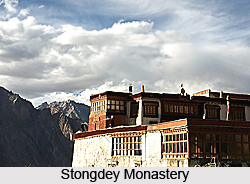 Stongdey monastery is the second largest monastic establishment of Zanskar, inhabited by Gelukpa monks. Stongdey is also spelled as Stongde, Stongday, Tonday or Thonde. This Buddhist monastery was built in the year 1052. It was founded by Naropa`s disciple, the famous translator Lama Marpa Lotsawa. Then it was taken over by the Gelugpa about four centuries later and became dedicated to Je Tsongkhapa. The monastery belongs to Gelugpa order of Buddhism which was introduced by the Lama Gyaltsampa Tundup Palzangpo. The successors of Nari Tulku mainly manage the monastery. The beauty of the monastery and the scenic view of the surrounding lures people form various parts of the country as well as world. Although the climb to the Stongdey Monastery is taxing, on getting there one is faced with a spectacular view of the surrounded valley.
Stongdey monastery is the second largest monastic establishment of Zanskar, inhabited by Gelukpa monks. Stongdey is also spelled as Stongde, Stongday, Tonday or Thonde. This Buddhist monastery was built in the year 1052. It was founded by Naropa`s disciple, the famous translator Lama Marpa Lotsawa. Then it was taken over by the Gelugpa about four centuries later and became dedicated to Je Tsongkhapa. The monastery belongs to Gelugpa order of Buddhism which was introduced by the Lama Gyaltsampa Tundup Palzangpo. The successors of Nari Tulku mainly manage the monastery. The beauty of the monastery and the scenic view of the surrounding lures people form various parts of the country as well as world. Although the climb to the Stongdey Monastery is taxing, on getting there one is faced with a spectacular view of the surrounded valley.
Location of Stongdey Monastery
The monastery is located in Stongdey near Padum in Kargil district of Jammu and Kashmir. It is 18 km from Padum in Zanskar region.
Attractions of Stongdey Monastery
The monastery is strategically built at the top of a rocky cliff and its architecture is quite different from other monasteries of the place. This white-washed monastery complex is constructed in Tibetan style of architecture. It is made in such a way that it provides panoramic views of Zanskar region.
It houses a number of temples, each a storehouse of the region"s rich conventual legacy. The monastery also exhibits some images of Buddha and is home to ancient murals, thangkas, and religious scriptures.
The monastery houses around 60 monks. It plays a key role in the lives of the locals. In fact, strong influence of the monastery can be observed over the surrounding villages.
The annual festival of the monastery is Gustor festival which is celebrated with great enthusiasm. It is organised on the 28th and 29th day in the eleventh month of the Tibetan calendar. Mask dance by Lamas is the highlight of the occasion. The festival also exhibits myriad handicrafts that are created by the locals.
Connectivity of Stongdey Monastery
It can be accessed by road that leads to Zangla. This extensive whitewashed temple complex can also be reached on foot. Local transport is available from Padum.



















